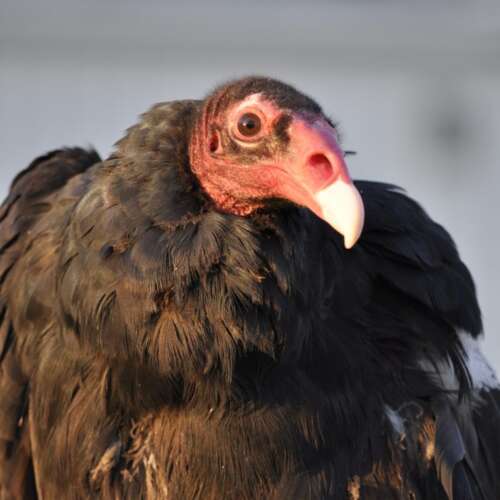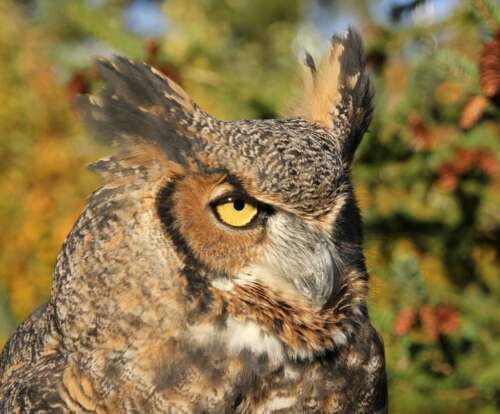
The turkey vulture extends its wing ─ its only wing ─ as if to say, “Look what happened to me.” The bird, named Socrates, is one of several non-releasable birds of prey being cared for at Wild Ontario, a non-profit, student-run organization based at the Ontario Veterinary College (OVC). The student volunteers are trying to raise $250,000 to build a new facility at the Arboretum to house the birds and educate the public.
“This is what I’ve always wanted to do,” says Jenn Bock, director of Wild Ontario and a 2007 U of G zoology grad. “I really like teaching the public about wildlife.”
She begins her lesson by explaining that some of the fastest, strongest and most intelligent birds ─ peregrine falcons, great horned owls and vultures ─ are found in Ontario.
Public education is an important part of Wild Ontario’s mandate. The birds have visited elementary and high schools, Boy Scout and Girl Guide clubs, the Ontario Science Centre and the Royal Ontario Museum.
Each bird has a story, and each story begins with a tragic encounter with humans.
Socrates was hit by a car. When he was brought to OVC’s Wild Bird Clinic in 1987, his wing was so badly damaged it couldn’t be saved. But the pioneering surgical technique used to treat him has since been perfected and used to save other birds with similar injuries.
Socrates is one of the lucky ones. Even though he lost his wing, he was spared a less fortunate fate. Mending a broken wing involves costly surgery that can reach several thousand dollars. Since wild birds don’t have owners who can foot the bill, rescue centres that can’t afford to perform these procedures are faced with only one option: euthanasia.
The Wild Bird Clinic at OVC treated birds for release into the wild until it closed in 2006. The students at Wild Ontario don’t treat injured birds, but they make referrals to facilities like the Toronto Wildlife Centre.

The program draws student volunteers who are passionate about wildlife. “It seemed like a really good cause, raising awareness for animals that can’t do it themselves,” says volunteer Jon Spero, a third-year zoology student. He looks after a female great horned owl named Einstein, who was brought to the Wild Bird Clinic as a chick 16 years ago when someone cut down the tree in which she was nesting with her two siblings.
Spero and the other volunteers take the birds out for walks around campus. “We go into the woods. I think she enjoys it,” he says, adding that Einstein often hears and sees things before he does.
The volunteers undergo an extensive training process that takes one semester to complete. It begins with an interview to find out how their personalities match with those of the birds. Each student is then assigned to a particular bird, and they begin to develop a bond. Some birds, like Socrates, are selective about their handlers and will only bond with students they trust.
The volunteers must complete 13 lessons covering such topics as bird anatomy, husbandry and dietary requirements. They take turns feeding the birds, a task that involves gutting chickens and mice. They also examine the birds for health problems, weigh them and clean out their cages.
Alexis Jordan, a fourth-year biological sciences student, is a volunteer in training who was paired with Indiana Jones, a red-tailed hawk that was illegally taken from the wild for falconry.
“A lot of people don’t realize the human impact on animals,” she says. “These birds are non-releasable because of human contact. We share their tragic stories of why they can’t go back into the wild.”